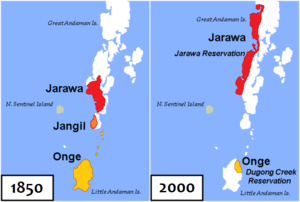翁奇語系
| 翁奇語系 | |
|---|---|
| 南安達曼語系 | |
| 地理分佈 | 安達曼群島 |
| 譜系學分類 | 世界主要語系之一 |
| 分支 |
詹吉爾語 †
哨兵島語 ?
|
| – | |
| Glottolog | jara1244[1] |
 翁奇語系的分布,1850年之前(圖1)與2005年(圖2) | |
翁奇語系(Ongan、Angan[2]、南安達曼語系、Jarawa–Onge)是分布在安達曼群島南部的語系,由至少兩種語言組成。 已知兩個現存語言是
- 翁奇語,96使用者(翁奇人,1997),主要為單語者
- 加洛瓦語,約200使用者(加洛瓦人,1997),單語
- 哨兵島語,據推測是哨兵島人的語言,有人認為屬於翁奇語系,但實際上幾乎沒有任何資料;估計有15–500使用者。
- 詹吉爾語於1895至1920年間滅絕,據載與加洛瓦語無法互通,但有明顯的相似之處。
外部關係[編輯]
安達曼諸語言可分為2個語系:大安達曼語系與翁奇語系,以及一種幾乎沒有記載的哨兵島語。大安達曼語系和翁奇語系之間有類型學和形態上的相似,而幾乎沒有共同的詞彙。就連約瑟·哈羅德·格林伯格這樣的遠距比較研究者,也對安達曼語系的成立表示懷疑。[3]
Juliette Blevins (2007)提出,翁奇語系與南島語系有遠緣關係,構成南島-翁奇語系。[4]但這沒有得到其他學者的認可,無我 (2011)認為Blevins的證據「並不令人信服,儘管有些相似之處可能是接觸/借詞造成的。Hoogervorst (2012)也持類似觀點。[5][6]Robert Blust (2014)認為Blevins的結論沒有數據支持:在前25個構擬中,沒有一個可用比較法構擬,Blust還認為語法比較也不成立。此外,Blust還引用了非語言學(如文化、考古與生物)證據反駁Blevins的假說。[7]
構擬[編輯]
兩種有據可查的翁奇語系語言比較接近,歷時構擬比較簡單:
| 原始翁奇語 | *p | *b | *t | *d | *kʷ | *k | *ɡ | *j | *w | *c | *ɟ | *m | *n | *ɲ | *ŋ | *l | *r |
|---|---|---|---|---|---|---|---|---|---|---|---|---|---|---|---|---|---|
| 加洛瓦語 | p, b | b | t | d | hʷ, h | h | ɡ, j | j | w | c | ɟ | m | n | ɲ | ŋ | l | r |
| 翁奇語 | b | b | t, d | d, r | kʷ, h | k, ɡ | ɡ, Ø | j | w | c, ɟ | ɟ | m | n | ɲ | ŋ | l, j | r/j/l, Ø |
| 原始翁奇語 | *i | *u | *a | *e | *o | (*ə) |
|---|---|---|---|---|---|---|
| 加洛瓦語 | i | u | a | e, ə, o | o | (ə) |
| 翁奇語 | i | u | a | e, ə, o | o | (ə) |
*ə傾向於是*e在鼻韻尾前的同位異音。
語法[編輯]
翁奇語系語言是黏着語,有豐富的前後綴系統,還擁有與眾不同的名詞分類系統。[9][10]名詞、形容詞會據與之相關(基於形狀或功能)的身體部位加前綴。[11]身體部位詞彙具有不可讓渡的領屬性,需要加領屬形容詞前綴,這個身體部位詞才能成立。例如不能單說「頭」,必須說「我的頭、你的頭」云云。[11]
翁奇語代詞:
| 我/我的 | m- | 我們/我們的 | et-, ot- |
| 你/你的 | ŋ- | 你們/你們的 | n- |
| 他/她/它/他的/她的/它的 | g- | 他們/他們的 | ekw-, ek-, ok- |
還有不定前綴ən-, on-「某人的」。加洛瓦語沒有複數系列,但單數非常接近: m-, ŋ-或n-, w-, ən-。由此,Blevins構擬原始翁奇語*m-、*ŋ-、*gw-、*en-。
根據現有資料,安達曼語言只有兩個基數詞:1和2。他們所有的數詞分別是(翻譯為漢語):1、2、多一個、一些、全部。[10]
另見[編輯]
- 原始翁奇語詞表(維基詞典)
參考文獻[編輯]
- ^ Hammarström, Harald; Forkel, Robert; Haspelmath, Martin; Bank, Sebastian (編). Jarawa–Onge. Glottolog 2.7. Jena: Max Planck Institute for the Science of Human History. 2016.
- ^ Abbi, Anvita. 2013. A Grammar of the Great Andamanese Language. Brill's Studies in South and Southwest Asian Languages, Volume 4.
- ^ Greenberg, Joseph (1971). "The Indo-Pacific Hypothesis." Current Trends in Linguistics Vol. 8, ed. by Thomas A. Sebeok, 807.71. The Hague: Mouton.
- ^ Blevins, Juliette, A Long Lost Sister of Proto-Austronesian? Proto-Ongan, Mother of Jarawa and Onge of the Andaman Islands (PDF), Oceanic Linguistics, 2007, 46 (1): 154–198 [2023-11-30], S2CID 143141296, doi:10.1353/ol.2007.0015, (原始內容存檔 (PDF)於2022-12-26)
- ^ van Driem, George. Rice and the Austroasiatic and Hmong-Mien homelands. N.J Enfield (編). Dynamics of human diversity: the case of mainland Southeast Asia. Canberra: Pacific Linguistics. 2011 [13 November 2021].
- ^ Hoogervorst, Tom. Southeast Asia in the ancient Indian Ocean world: combining historical linguistic and archaeological approaches (學位論文). University of Oxford. 2012 [2021-11-13]. (原始內容存檔於2021-11-13).
Nevertheless, it is conceivable that some of the given forms are genuinely related, though better explained as loans than common inheritance (p. 91).
- ^ Blust, Robert (2014). "Some Recent Proposals Concerning the Classification of the Austronesian Languages", Oceanic Linguistics 53:2:300–391. "To put it bluntly, the AON hypothesis is a castle built on sand, an elaborate illusion fostered by the misplaced hope that a major discovery has been made that somehow eluded the investigations of all other scholars."
- ^ 8.0 8.1 Blevins (2007).
- ^ Abbi, Anvita. Endangered Languages of the Andaman Islands. Lincom Europa. 2006. ISBN 978-3-89586-866-5.
- ^ 10.0 10.1 Temple, Richard C. A Grammar of the Andamanese Languages, Being Chapter IV of Part I of the Census Report on the Andaman and Nicobar Islands. Port Blair: Superintendent's Printing Press. 1902.
- ^ 11.0 11.1 Burenhult, Niclas. Deep Linguistic Prehistory with Particular Reference to Andamanese. Working Papers, Lund University, Dept. Of Linguistics. 1996, 45: 5–24.
閱讀更多[編輯]
- Das Gupta, D. and S. R. Sharma. A Handbook of the Önge Language. Anthropological Survey of India: Calcutta 1982.
- E. H. Man, Dictionary of the South Andaman Language, British India Press: Bombay 1923.
- Senkuttuvan, R. 2000. The Language of the Jarawa: Phonology. Calcutta: Anthropological Survey of India, Government of India, Ministry of Culture, Youth Affairs, and Sports, Dept. of Culture.
- Sreenathan, M. 2001. Jarwa - Language and Culture. Anthropological Survey of India, Ministry of Culture, Government of India, Kolkata
